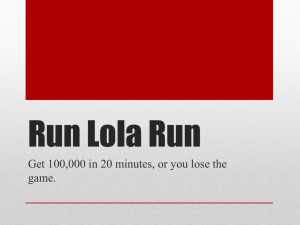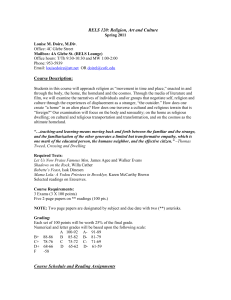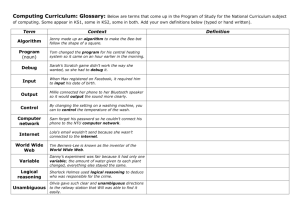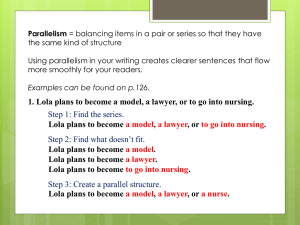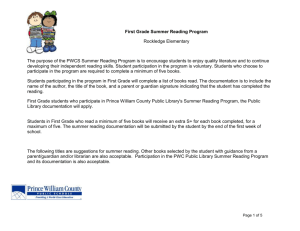File
advertisement
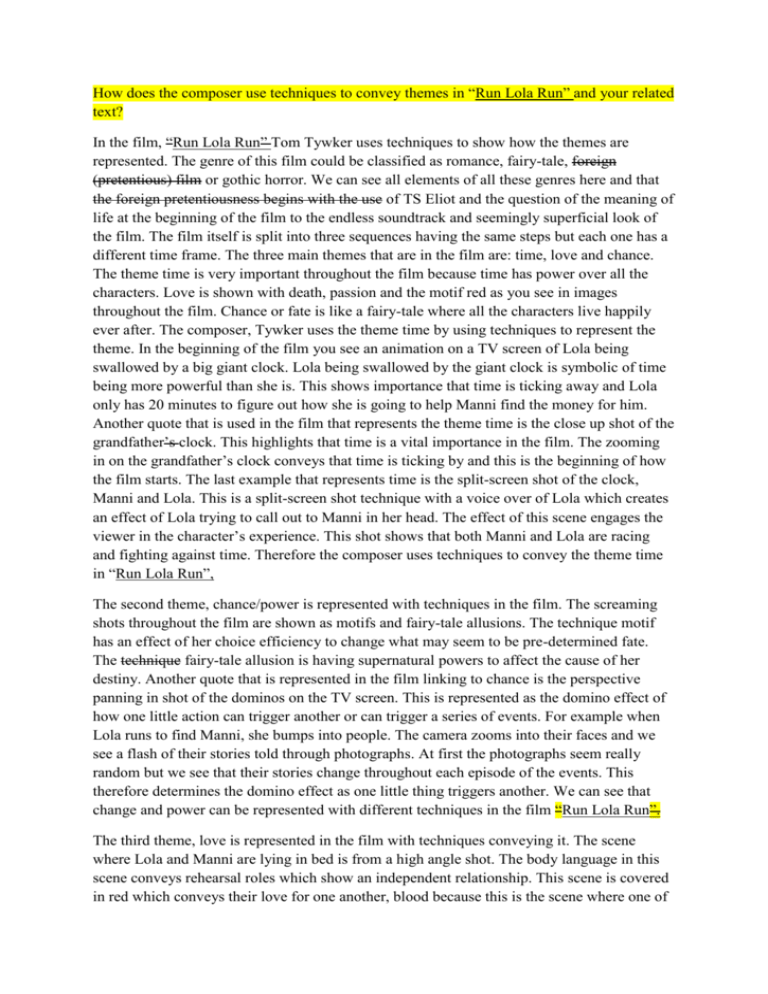
How does the composer use techniques to convey themes in “Run Lola Run” and your related text? In the film, “Run Lola Run” Tom Tywker uses techniques to show how the themes are represented. The genre of this film could be classified as romance, fairy-tale, foreign (pretentious) film or gothic horror. We can see all elements of all these genres here and that the foreign pretentiousness begins with the use of TS Eliot and the question of the meaning of life at the beginning of the film to the endless soundtrack and seemingly superficial look of the film. The film itself is split into three sequences having the same steps but each one has a different time frame. The three main themes that are in the film are: time, love and chance. The theme time is very important throughout the film because time has power over all the characters. Love is shown with death, passion and the motif red as you see in images throughout the film. Chance or fate is like a fairy-tale where all the characters live happily ever after. The composer, Tywker uses the theme time by using techniques to represent the theme. In the beginning of the film you see an animation on a TV screen of Lola being swallowed by a big giant clock. Lola being swallowed by the giant clock is symbolic of time being more powerful than she is. This shows importance that time is ticking away and Lola only has 20 minutes to figure out how she is going to help Manni find the money for him. Another quote that is used in the film that represents the theme time is the close up shot of the grandfather’s clock. This highlights that time is a vital importance in the film. The zooming in on the grandfather’s clock conveys that time is ticking by and this is the beginning of how the film starts. The last example that represents time is the split-screen shot of the clock, Manni and Lola. This is a split-screen shot technique with a voice over of Lola which creates an effect of Lola trying to call out to Manni in her head. The effect of this scene engages the viewer in the character’s experience. This shot shows that both Manni and Lola are racing and fighting against time. Therefore the composer uses techniques to convey the theme time in “Run Lola Run”, The second theme, chance/power is represented with techniques in the film. The screaming shots throughout the film are shown as motifs and fairy-tale allusions. The technique motif has an effect of her choice efficiency to change what may seem to be pre-determined fate. The technique fairy-tale allusion is having supernatural powers to affect the cause of her destiny. Another quote that is represented in the film linking to chance is the perspective panning in shot of the dominos on the TV screen. This is represented as the domino effect of how one little action can trigger another or can trigger a series of events. For example when Lola runs to find Manni, she bumps into people. The camera zooms into their faces and we see a flash of their stories told through photographs. At first the photographs seem really random but we see that their stories change throughout each episode of the events. This therefore determines the domino effect as one little thing triggers another. We can see that change and power can be represented with different techniques in the film “Run Lola Run”. The third theme, love is represented in the film with techniques conveying it. The scene where Lola and Manni are lying in bed is from a high angle shot. The body language in this scene conveys rehearsal roles which show an independent relationship. This scene is covered in red which conveys their love for one another, blood because this is the scene where one of them dies and it also conveys danger, anger and death. The red symbolises change for example the phone and Lola’s hair and the flashbacks. Their love keeps them alive until all events of chance and choices of people coincide to allow them to both to survive their experiences. As they continue living for love, viewers are reminded that love is the most powerful of all emotions for example, in the first serious of events Lola is killed when the police catch her and Manni after they robbed the store. A man accidently shoots Lola and begins to die. She remembers an early conversation with Manni about their love and her commitment to them. Suddenly Lola seems to come back alive in the name of love and she begins the entire serious of events over again. Therefore the theme love is conveyed in the film with techniques shown. From the above, one can see that the composers does use techniques to convey the themes in the film “Run Lola Run”. All three themes, time, love and chance all have specific importances which convey the themes. The theme time is represented as the character are racing against it, love, the relationship between Lola and Manni and chance or power is with the bumping into people. Discuss how the distinctively visual conveys distinctive experiences in Run Lola Run and ONE other related text Introduction: The composer Twyker uses distinctively visual techniques to shape meaning and affect interpretation. He uses different genres like mixed games and video games. The genre, road movie is the tradition of moving from a beginning to an end. Like Thelma and Louise, Lola defies conventions and ends up without a place to go back into. Another genre used in the film which conveys distinctive visual experiences is slapstick which is the glass pane been carried across the road in the film and speculative fiction which is a typical ‘what if’ storyline. The mix of genres represents the postmodernism experience, where the composer captures the experience of living in the post-modern world without clear boundaries and categories through a distinctly post-modern techniques and structure. Body paragraph 1: Run Lola Run breaks traditional film principles to convey experiences that invent traditional social experiences, which conveys the changes occurring in Berlin of the late 1990s. Twyker uses symbolism to convey meaning and deepen the viewer’s understanding. It also demonstrates a different perspective on the traditional views and use of symbolism in Run Lola Run. The film Run Lola Run blends genres and uses various dynamic visual techniques to convey the distinctive experiences of the characters. The red motif is a distinctively visual technique used to convey the distinctive relationship between Lola and Manni, one of several of their experiences. The symbol red in the film Run Lola Run is used to convey meaning and to deepen the viewers understanding in the film. The traditional definition of the symbol red is that its uncontrolled lust of power leading to self absorption of power, hatred or blind passion and hell-born love. In the film, red symbolizes love, passion, which is an effect on Lola’s and Manni’s relationship with one another. Red is used throughout the play to convey the passion that is involved with the task at hand and their urgency. For example Lola’s hair is red which makes her the stand out character of the film. The symbol red shows distinctively visual images which are represented with distinctive experiences in Run Lola Run. Body paragraph 2: Another theme that conveys distinctive experiences in Run Lola Run is time. The compose uses the theme time by using different images which are represented in the film. In the beginning of them film you see an animation sequence on the TV screen and you see an image of Lola being swallowed by a giant clock. This is symbolic of time being more powerful than she is which creates a distinctive visual image. Another shot that is used in the film that represents the theme time is the close up shot of the grandfather. This highlights that time is of vital importance in the film. The zooming in on the grandfather’s clock conveys that time is ticking by and this is the beginning of how the film starts. The last example that represents time is the split-screen shot of the clock, Manni and Lola. This is a split-screen shot technique with a voice over of Lola which creates an effect of Lola trying to call out to Manni in her head. The effect of this scene engages the viewer in the characters experience. This shot shows that both Manni and Lola are racing and fighting against time. The theme of time is represented with images that represent distinctive experience. Body paragraph 3: The third theme, love is represented in the film with techniques conveying it. The scene where Lola and Manni are lying in bed is from a high angle shot. The body language in this scene conveys rehearsal roles which show an independent relationship. This scene is covered in red which conveys their love for one another, blood because this is the scene where one of them dies and it also conveys danger, anger and death. Their love keeps them alive until all events of chance and choices of people coincide to allow them to both to survive their experiences. As they continue living for love, viewers are reminded that love is the most powerful of all emotions for example in the first serious of events Lola is killed when the police catch her and Manni after they robbed the store. A man accidently shoots Lola and begins to die. She remembers an early conversation with Manni about their love and her commitment to them. Suddenly Lola seems to come back alive in the name of love and she begins the entire serious of events over again. The theme love is represented with distinctive experiences which are conveyed by distinctively visual images. Looking at the themes of time, love and symbolism we can see that the composer Twyker uses visual techniques to represent the relationship between the characters, for instance Lola and Manni, in the film. The theme of time is represented where Lola is being swallowed by the clock represented time being more powerful then she is the theme of love is shown where both Manni and Lola’s love keeps them alive until all events of chance and choices of people coincide to allow them to both to survive their experiences. The last theme, symbolism is shown with the spirals as this shows confusion and desperation with both characters. Q1) How are visual techniques used to develop the relationship between characters in run Lola run? Run Lola Run is a film that uses multiple sequences of the same time frame and various film techniques to portray the relationship between Lola and Manni, the man she loves. While the colour red works as a love motif, flashbacks, flash forwards, domino effects, high angle, low angle and tracking shots are the main visual techniques used to convey their developing relationship. The Clocks are a metaphor for time, another powerful visual device showing their relationship. It acts as the antagonist against them. Essentially, “time” brings them closer together The domino effect is a theme that is used to show the developing relationship of Lola and Manni. Lola is first depicted in a cartoon scene where we see her running through maze. She seems to be running for her life. A tracking shot has been used to convey speed and catch her collisions with destiny. The cartoon foreshadows the domino effects that run through the various scenarios in the film. We see dominos falling in black and white on a television which symbolises the domino effect, how one insignificant event can trigger a catastrophic event in the future. An example of this is when Lola bumps into the Old woman on the deserted street. We then see a fast forward of her life in still frames. Each time their paths collide, the conclusion of the woman’s life changes. This shows the domino theme in full effect. We already know the film is one about chance and fate. Used often, the clock motif is a dominant one: Lola and Manni are constantly competing against time, the antagonist, allowing them to progress with their relationship. The first scene shows a threatening, menacing clock with twirling hands. The fast forward technique is put in motion to remind the viewer how time is always ticking, every second counts. Tracking shots are used throughout the film to follow Lola as she runs through the streets in her race against time. The triple split screen shows the perspectives of both Manni and Lola as she runs to meet him. From Manni’s perspective we know he is concerned about time as he is looking at a clock. Lola’s lateness draws our attention to the films preoccupation with time. The third screen employs a close up of a clock with the seconds being counted down. This emphasises each second passing in order to suggest its domino effect in the lives of Lola and Manni. The clock is personified in the split screens so as to give time vital significance throughout the film. This being said the triple split screen projects the relationship between Lola, Manni and time. Several visual technique motifs are used to convey Lola and Manni’s constantly changing relationship. Screaming, another motif, emphasises danger, fear and pain. We see Lola in full zoom “screaming.” The zoom effect magnifies her emotion and draws our attention to her “red” hair. The red motif evokes associations with love, passion, danger, blood and even death. This motif recurs powerfully in a monochrome “red scene” where Lola and Manni explore their love. She questions whether his love for her is genuine as she is unconvinced. Their constant exploration of their love tracks the progress of their relationship as they are learning to understand each other. Lola and Manni’s relationship is conveyed throughout the film with the use of visual film techniques. These techniques create a strong thought in the viewers mind about Lola and Manni’s constantly changing relationship. After the first two scenarios we see their relationship end badly, but the third ends happily where they are finally together with a new understanding of each other. These trials or re-runs, if you will, are an ongoing reshape of their relationship. With the addition of visual techniques, their relationship could be tracked and monitored by the viewer. In other words, the different scenarios show and track the possibilities of their relationship, where by the end we see their developing relationship blossom. Introduction Composers use distinctively visual techniques to convey distinctive experiences within our lives, such as the race against time, duties imposed by relationships and making choices. This is exemplified through the film Run Lola Run! and the poem “The Love Song of J.Alfred Prufrock” (hereafter “Prufrock”). Twyker conveys the experiences of time being insuperable, relationships being a burden and choices being left to chance. This is demonstrated through the use of split screens, fast cutting shots and close ups. However, T.S. Elliot illustrates these experiences through extended metaphors, allusions and other imagery. Ultimately, the composers force the responder to compare their experiences to Lola’s and Prufrock’s and to share in their frustration. Paragraph 1: The composers of both Run Lola Run and “Prufrock” convey time as insuperable. Lola’s lack of time in Run Lola Run creates a deepened understanding of the urgency and brevity of life. The repetition of the number “20”, such as the close up of the roulette table ironically landing on “20”, reiterates the “countdown” towards Manni, who is Lola’s final destination. Thus, Twyker uses Lola’s race against time to get to Manni to mirror the way we live our lives rushing from one “destination” to another. On the other hand, in “Prufrock” time being insuperable is apparent to the responder, whereas Prufrock believes there is “time yet for a hundred indecisions.” This reveals Prufrock’s complacency, contradicting the images of ageing scattered throughout the poem, for example Prufrock’s “bald spot” and “white flannel trousers.” Consequently, the composers use visual techniques to contrast how their protagonists experience and perceive time: Lola is racing against time and is aware of this, while Prufrock thinks “there will be time” even when, like Lola, he is racing against the clock. Paragraph 2: Duties imposed by relationships in the two texts show the responder how relationships may encumber those involved. Run Lola Run conveys the burden of relationships through Lola’s decisions to continually try to save Manni. This is shown through the use of the fast cutting shot as she decides to run into the bank and tries robbing it, showing that love robs us of reason: love conquers all. In sequence two, Twyker uses a close up of Lola’s emotionless face as her father says to her, “the police will be here in a second.” Her indifference to the police demonstrates that she knows that she has to save Manni, which symbolises the duties love places on individuals in a relationship. In contrast, “Prufrock” has no duties involved with relationships as he takes no risks. The extended metaphor evoking an image of a cat which “curled once about the house” shows how he is withdrawing from any relationships, as cats are lonesome and fickle. Therefore, the composers use visual techniques, such as fast cutting shots and metaphors, to represent two typical experiences of relationships. Lola shows us that love conquers all, whereas Prufrock shows us how relationships are not needed in life but even though remaining unattached may reduce one’s responsibilities, it may also cause loneliness. Paragraph 3: Finally, Twyker and Eliot use visual techniques to convey the distinctive experience of making choices. Twyker’s use of flicking of head shot images at the start of sequence one allows the viewer to visualise Lola’s thought process and to symbolise her indecision. In “Prufrock”, an allusion to “Prince Hamlet” creates a futile image of the narrator as an indecisive, middle-aged man (or “a patient etherised upon a table”) who is always looking for the opportune moment to act. The experience of choosing the “opportune moment” suggest that choices, even though they are our own, inevitably involve an element of chance. Twyker uses the visual technique of cutting to childish animation to imply that our choices are like those in a video “game”. Even though Lola chooses to act, chance events prevent her from reaching Manni. Consequently, while Eliot uses visual techniques to cast a negative light on making choices, Twyker uses them to encourage us to experience choices more light-heartedly. Conclusion Ultimately, the composers of Run Lola Run and “The love song of J. Alfred Prufrock” use distinctively visual techniques to convey the distinctive experiences of racing against time, the duties imposed relationships and choices being left to chance. These techniques include metaphors and allusions that conjure up images of a “cat” and “Prince Hamlet”, and fast cutting shots and close ups of Lola’s face that depict her thought processes and the burdens of love. As both texts deal with chaos in their own way, it might be suggested that the fundamental distinctive experience is of chaos and indecision. Yet, as Lola does with her ability to rewind time and Prufrock’s wondering mind, we see how visual techniques can allow us to enter a new realm of “unreality” created by the composer. Here, in this visual “unreality”, we can learn by comparing our experiences to those of the fictitious characters.
